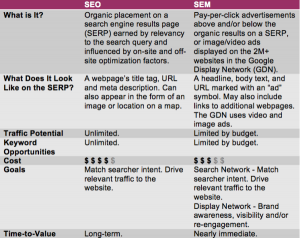SEO best practices are constantly changing, so brands must keep up if they want to stay on top of search engine rankings. SEO has become a key tool in brand promotion, and effective tactics tend to change as Google shifts their algorithm. To stay on top of SEO trends in the second half of this year, a marketing team must take an all-encompassing approach. SEO can be broken down into three key areas: Technical, User Experience, and “Fat” Content. Each of these areas needs to be addressed in order to run a successful SEO campaign.
Technical SEO
There are some SEO elements where you need to know a bit of code, or at least how to read the skeleton of a website. Performing strong keyword research is key for this step, because those keywords will be integrated into all aspects of your website from meta descriptions to title tags. Technical SEO means making sure each and every page on your website has a clear description and gets read by Google correctly. Important elements include:
– Proper Keyword Usage: Keywords should be used (but only 1-2 times) in the following: URLs, meta descriptions, page titles, website text, ALT attribute, canonical tags and H1 tags.
– Website Errors: There should be no 404 or server errors on the website, nor should there be any duplicate content.
– Technical Content: Page titles and navigation menus should include keywords, and the landing page content above the fold should provide enough information about the website. Additionally, the sitemap should regularly be updated.
User Experience
User experience is key when it comes to SEO. Your website, which should be generated by designers and content creators together, needs to be easy to navigate and use. What do you want your user to do? Contact you? Purchase something? This is sometimes called “inbound marketing”, but it’s important to keep UX in mind when designing (or restructuring your website). Important elements include:
– Website Structure: Does the website structure make sense? Your site must also be optimized for mobile (or you may get docked by Google).
– Website Speed: Slow websites are bad from an SEO and UX perspective. Make sure all images are optimized and compressed and clean up any excess JS or CSS on the site.
“Fat” Content
Now dubbed “fat” and “thin” content, Google distinguishes between types of content on a website and social media. First, the content on your site must be “fat”, which means eBooks, white papers, strong, shareable blogs. You don’t want “thin” content which is poor guest posts and outdated text. This goes for social media as well. Your social networks all go towards your SEO, so choose what networks you want to focus on and make them great.
Another part of content is public relations. Some call this “the new link building”, but you want strong content being written about your company, linking to your site as well. These inbound links can be from press releases or stories about your company, but the stronger the source (aka where the post comes from), the stronger your website optimization will be.
SEO tactics change frequently, but these tactics will get you through the rest of this year. If you haven’t thought about some of these elements, then make sure you do before we see another Google algorithm update.
This post originally appeared on Uplifted’s Blog
(182)



